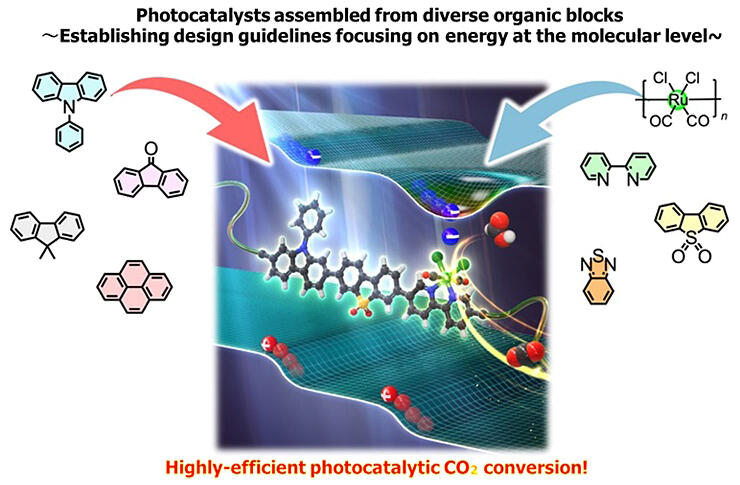A research group led by Lecturer Akinobu Nakada, Master's Student Kotaro Ishihara (at the time of the research), and Professor Ryu Abe from the Graduate School of Engineering, Kyoto University, in collaboration with Professor Akinori Saeki from the University of Osaka and Professor Akira Yamakata from Okayama University, has developed an organic polymer photocatalyst with built-in complex catalyst that enables highly efficient carbon dioxide conversion. Their research was published in the Journal of the American Chemical Society.

Provided by Kyoto University
The development of excellent photocatalysts that mimic plant photosynthesis reactions and convert carbon dioxide (CO2) using light energy is highly anticipated. In relatively high-efficiency CO2 conversion photocatalysts that have reported reaction quantum efficiencies exceeding 30%—one of the indicators showing photoreaction efficiency—rare metals such as ruthenium and rhenium have been used as light-absorbing sites.
The research group selected three types of combinations suitable as donor, π-spacer, and acceptor from diverse conjugated organic molecular frameworks, connected them in appropriate sequences, and introduced reaction centers consisting of metal complexes to the acceptor sites, thereby developing highly efficient photocatalysts that far surpass conventional systems. By controlling the energy level differences between the connected organic units, the group formed multi-step energy gradients that are also employed in natural photosynthesis, establishing design principles that enable spontaneous charge separation within the photocatalyst material without relying on electrodes or conductors.
Through ultrafast spectroscopic measurements and theoretical calculations, the research group demonstrated that excited electrons generated by light absorption can swiftly migrate to the reaction centers and form excellent charge-separated states. They optimized the photocatalyst structure in such a way that organic polymers composed of carbon, nitrogen, hydrogen, oxygen, and sulfur act as light-absorbing sites of the photocatalyst. Using the optimized photocatalyst, they achieved a maximum quantum yield of 32.2% for CO2 conversion under visible light irradiation and successfully generated formic acid at a high concentration of 0.48 mol/L. The quantum yield of the reaction showed a dramatic 18-fold improvement compared to conventional systems linking two types of units, recording the highest value reported to date for CO2 reduction photocatalytic reactions proceeding solely through light absorption by organic molecular frameworks.
Journal Information
Publication: Journal of the American Chemical Society
Title: Molecular-Level Tailoring of Energy Structure in Ternary Conjugated Polymers with a Built-in Ru-Complex Catalyst for Efficient CO2 Reduction Photocatalysis
DOI: 10.1021/jacs.5c04222
This article has been translated by JST with permission from The Science News Ltd. (https://sci-news.co.jp/). Unauthorized reproduction of the article and photographs is prohibited.




